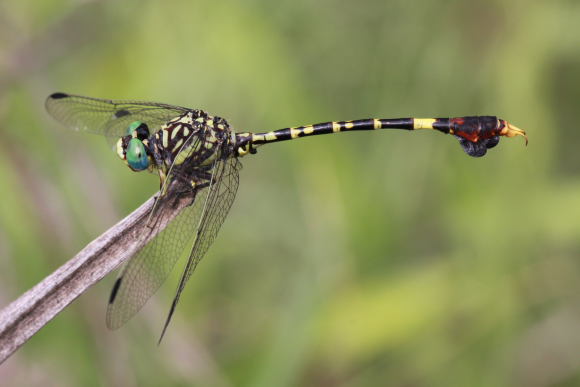Genus Paragomphus Cowley, 1934
hooktails
Type species: Gomphus cognatus Rambur, 1842
Introduction
Genus inhabits the warm parts of Africa and Eurasia with almost 30 species known in Africa and more likely to be discovered. They are among the most often encountered gomphids, although in much of Africa the vast majority will be P. genei, which is usually recognised by the green thorax with fairly (but variably) indistinct brown markings and pale-centred pterostigmas (with green tinge). The distinctive posterior hamule immediately rules out other species in the hand. The species are small to medium-sized (hindwing 18-33 mm) and very diverse in appearance and ecology. P. genei can breed in almost any open water body, including temporary ones, as well as sunny forest streams. However, most species require permanent streams or rivers.
The fritillarius-group, named after a Madagascan species, favours (often large) rivers: P. acuminatus, P. sabicus and P. zambeziensis differ strongly from other Paragomphus in the finely-pointed diverging cerci. The elpidius-group has a largely green thorax, parallel and blunt-tipped cerci, and relatively short epiproct. They inhabit exposed and/or large water bodies. Exuviae of P. nyasicus line the beaches of Lake Malawi in huge numbers, and P. lacustris may have a similar ecology in Lake Tanganyika, although adults have been collected distantly in DR Congo, while P. cataractae, P. elpidius and P. lemperti are found at open and often large rivers.
In contrast to the previous species, the cognatus-group favours sheltered streams, often (P. abnormis, P. alluaudi, P. cammaertsi, P. cognatus, P. serrulatus, P. viridior) or exclusively (P. clausnitzerorum, P. crenigomphoides, P. darwalli, P. kiautai, P. machadoi, P. nigroviridis, P. tournieri) in forest. Including almost half the species, the taxonomic problems in the genus reside largely in this group and they must be identified with care. The large and bizarre species P. aureatus, P. dispar and P. maynei are each known from only a single rainforest site in Central Africa. The taxonomic affinities and precise preferences of the distinctive P. magnus, P. pumilio and P. sinaiticus are unclear. [Adapted from Dijkstra & Clausnitzer 2014]
Diagnosis
Male of genus is similar to Crenigomphus (of which Paragomphus is probably a synonym) by (a) anal loop absent; (b) anal triangle of 4 cells, sometimes 3-6; (c) hind femur shorter than breadth of head; (d) cerci without inner branch, but sometimes with inner tooth; (e) epiproct shorter than cerci; (f) branches of epiproct touch or lie close to each other, often bear dorsal process between base and apex. However, differs by (1) Pt pale to black, costa anterior to it black, thus contrasting with remainder of costa and/or Pt when these pale (only P. crenigomphoides has costa anterior to Pt pale); (2) tips of cerci parallel or diverging, with teeth fewer, smaller and/or not in ridge; (3) epiproct at most half as long as cerci. [Adapted from Dijkstra & Clausnitzer 2014]

Paragomphus sabicus Pinhey, 1950. Male © Jens Kipping
Map citation: Clausnitzer, V., K.-D.B. Dijkstra, R. Koch, J.-P. Boudot, W.R.T. Darwall, J. Kipping, B. Samraoui, M.J. Samways, J.P. Simaika & F. Suhling, 2012. Focus on African Freshwaters: hotspots of dragonfly diversity and conservation concern. Frontiers in Ecology and the Environment 10: 129-134.
References
- Legrand, J. (2003). Les Odonates du Nimba et de sa région. In: Lamotte, M. & R. Roy (Editors), Le peuplement animal du mont Nimba (Guinée, Côte d’Ivoire, Liberia). Mémoires du Muséum national d’Histoire naturelle, 190, 231-310. [PDF file]
- Clausnitzer, V. and Dijkstra, K.-D.B. (2005). The dragonflies (Odonata) of Ethiopia, with notes on the status of endemic taxa and the description of a new species. Entomologische Zeitschrift, 115, 117-130. [PDF file]
- Dijkstra, K.-D .B. (2007). he name-bearing types of Odonata held in the Natural History Museum of Zimbabwe, with systematic notes on Afrotropical taxa. Part 1: introduction and Anisoptera. International Journal of Odonatology, 10, 137-170. [PDF file]
- Dijkstra, K.-D.B. (in prep.) Odonata of the Congo: checklist, bibliography, gazetteer, new records, species descriptions, and taxonomic notes with an emphasis on Elattoneura, Mesocnemis and Congothemis. Zoologische Mededelingen. [PDF file]
- Longfield, C. (1936). Studies on African Odonata, with synonymy and descriptions of new species and subspecies. Transactions Royal Entomological Society London, 85, 467-498. [PDF file]
- Pinhey, E.C.G. (1961). Dragonflies (Odonata) of Central Africa. Occasional Papers Rhodes-Livingstone Museum, 14, 1-97. [PDF file]
- Fraser, F.C. (1949). Gomphidae from the Belgian Congo (order Odonata). Revue Zoologie Botanique Africaines, 42, 101-138. [PDF file]
Citation: Dijkstra, K.-D.B (editor). African Dragonflies and Damselflies Online. http://addo.adu.org.za/ [2024-07-27].

